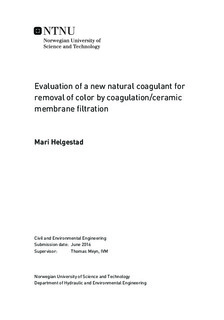Evaluation of a new natural coagulant for removal of color by coagulation/ceramic membrane filtration
Master thesis
Permanent lenke
http://hdl.handle.net/11250/2407595Utgivelsesdato
2016Metadata
Vis full innførselSamlinger
Sammendrag
This master thesis is based on experiments on a pilot plant at the department of Hydraulic and Environmental Engineering at NTNU. The master thesis is written for the Norwegian company INRIGO AS. The purpose of this master thesis is to evaluate a natural, organic coagulant called Ecotan bio s03, and to evaluate if the coagulant can be used for NOM removal on typical Norwegian surface water. Typical Norwegian surface water has a low pH, turbidity and alkalinity, and high concentration of color and NOM.
The pilot plant consists of coagulation, flocculation and membrane filtration through a ceramic membrane with 100 nm pore size. The raw water is tap water with additional NOM concentrate to imitate typical Norwegian surface water.
18 experiments were in total conducted, where 18 different conditions was evaluated. pH 6, 7.5 and 9 was chosen on the basis of the project thesis written during fall 2015. 20, 30, 40, 50, 60 and 70 mg EB3/l was the coagulant dosages used. The results did not live up to the expectations. The best result considering color was 61% removal and 16,26 mg Pt/l. A color residual far above the required level, and much higher than the project thesis. The best result considering carbon removal was 26,5% removal and 3,62 mg C/l, accomplished with the second lowest dosage at pH 6. pH 7,5 and 60 mg EB3/l resulted in 115% increase in carbon. The results illustrate that high coagulant dosages causes high carbon residual. Ecotan bio s03 contain a high concentration of carbon, which can make it difficult to reach the requirement considering carbon.
The results in this master thesis have been varying, causing difficulties making any conclusions. The experiments were initially scheduled to last for 48 hours, but most of them stopped earlier because of membrane clogging. On that basis the results considering TMP are difficult to draw any conclusions from. The conclusion is that the experiment should be per-formed one more time.
